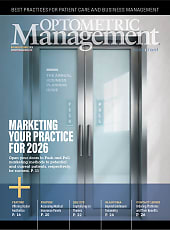Northeast | West | South | Midwest
So far, 2025 has been a good year to keep your seat belt fastened. Up, down, and all around pretty much describes the country’s business and economic climate in the first quarter of 2025.

How challenging is it? University of Michigan research reports that consumer sentiment in both April and May fell to its second-lowest levels since tracking began 73 years ago.
Looking ahead to later this year, many economists foresee the potential for stagflation on the horizon, which occurs when inflation rises and economic growth flattens or drops.
What does all this mean for your business and your patients? That’s exactly what we’ll address in this annual report.
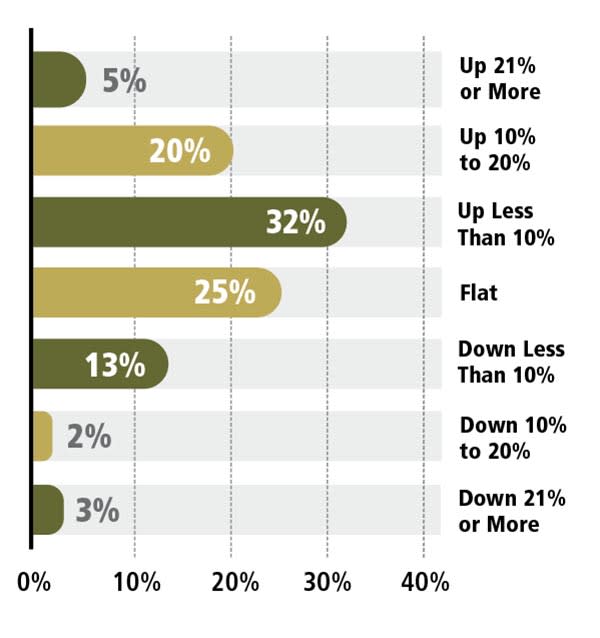
THE BOTTOM LINE
Q. How is your business and revenue picture trending in 2025 versus 2024?
“[The biggest challenge today is] breaking through the noise of low-cost providers and educating the public that they shouldn’t buy glasses and toilet paper at the same place. Their eyes deserve better care!” —2025 Annual Regional Market Trends Report respondent from the West
STRESS LEVELS
Stress levels are up across the board from last year. While ECPs in the Northeast report being the most stressed out, and those in the West the least, the nationwide average is 5.1 out of 10. That’s a notable increase from 3.9 last year, which was a significant drop from 6.1 in 2023, but today’s levels are creeping toward the post-pandemic stress of 5.7 in 2022.
Regions + Resources
Following this introductory look at trends from a nationwide perspective, EB will present the results of research conducted by the magazine from March through May. We surveyed your peers from all parts of the country and then divided them by location into the four U.S. Census Bureau regions—Northeast, West, South, and Midwest—to reveal how different parts of the country are performing compared with one another and the nation as a whole.
To gain a broader perspective on EB’s numbers, we also present trends and statistics from outside the industry. This year, our sources include the U.S. Bureau of Labor Statistics (BLS), the Federal Reserve, the National Retail Federation, and the Congressional Budget Office.
The information presented here is designed to help you map out your moves for the rest of this year as well as 2026. To that end, we address everything from what’s selling and what’s not, to what your peers’ practice and purchasing priorities are, and more.
The Unemployment Seesaw
Talk about ups and downs. According to BLS, in April 2023, the unemployment rate was 3.4%. That was only the second month since May 1969 when the rate fell below 3.5%. It has bounced around since then, and, as of this April, it is 4.2%.
Here’s a look at both extremes of the current employment picture—states with the highest jobless rates for April 2025 and those with the lowest.
| HIGHEST UNEMPLOYMENT | LOWEST UNEMPLOYMENT |
| District of Columbia 5.8% | South Dakota 1.8% |
| Nevada 5.6% | North Dakota 2.6% |
| Michigan 5.5% | Montana 2.7% |
| California 5.3% | Vermont 2.7% |
| Kentucky 5.2% | Hawaii 2.9% |
*Source: U.S. Bureau of Labor Statistics, April 2025
Demographic Data
• MORE FOLKS. The U.S. accounts for 4.2% of the world’s population, reports Worldometer. Our numbers increased by 0.54% between 2024 and 2025.
• SAY HELLO. The U.S. population grows every year. The biggest increase (of 1%) took place between 2019 and 2020. Looking decade over decade, however, the rate of growth is slowing. Between 2000 and 2010, the U.S. population grew by 10%. Between 2010 and 2020, it slowed to a 7.4% increase.
• CITY LIFE. According to information released by the Census Bureau in May, U.S. cities are booming. In fact, between 2023 and 2024, cities of all sizes grew, with the biggest population increases seen in Southern and Western cities.
• GETTIN’ OLD. According to Worldometer, the median age in the U.S. is 38.5 this year. What a contrast that is from 1960, when it was 28.
How does all of this relate to you? It means that your patients’ needs will be changing as the average age increases—and so will the products and services they require.
Who + Where
Eyecare professionals from all four census regions were surveyed: Nearly a third (32%) practice in the Midwest, just over a quarter (26%) are in the West, and an equal representation (21%) of respondents run their businesses in the Northeast and the South. Among those surveyed, 53% are optometrists and 31% are opticians. In terms of their number of locations, just over half (56%) have one location, 25% operate two or three, 8% are associated with four to 10 locations, and another 12% have more than 10 business sites.

THE GROWTH PICTURE
Q. In which pricing tier for all products (frames, lenses, contact lenses) are you seeing the most growth on the retail side of your business today?
The Big Picture
With the partial tariff rollback in mid-May, “The growth outlook is looking less cloudy,” reports Comerica in its May 2025 U.S. Economic Outlook report. Looking at the full year, Comerica reports that “the economy still looks set to register slower growth in 2025 than in 2024. But recession risk is unlikely to worry the Fed enough to corral them into cutting rates.”
As for inflation, it dropped to 2.1% in April, which is lower than expected and suggests that it may be slowing. The unemployment rate, as tracked by BLS, remained at 4.2%, which was unchanged from a month earlier.

OPPORTUNITY KNOCKS
Q. What is the greatest area of opportunity on the retail side of your business today?
“[The biggest challenge today is that] we cannot foretell the future despite all of our efforts to do so. If there were some hope of predictability of the stability of pricing in the industry, I would be less concerned. The majority of my products…are produced overseas. If tariffs are a moving target, how can I possibly set prices? Customers would end up driving around the neighborhood looking for the best price for product as we do for gasoline.” —Cerrill Meister, Eye Candy Opticianry Inc., Baltimore, MD
New Directions
Almost all Americans are spending more time online than a year ago. How is that reflected in optical? Here’s some of what ECPs surveyed for this report shared with EB.
• SOCIAL MEDIA. Facebook continues to be the platform of choice for business, with 53% of ECPs reporting it is their preferred channel. That’s down from the 64% who pointed to it last year. The biggest year-over-year increase? Instagram, with 28% of ECPs saying they prefer it over other platforms, significantly up from 10% last year.
• ONLINE RETAIL. Though 69% of respondents report they don’t sell anything online, one-quarter of those who do say they currently offer contact lenses on the internet, 12% sell plano sunwear, 11% sell Rx eyewear, and 10% offer Rx sunwear. When asked about future plans, 71% of those who currently don’t sell online say they have no plans to do so within the next two years.
Business Trends
Retail sales are up. According to the U.S. Census Bureau, “Total sales for the February 2025 through April 2025 period were up 4.8% from the same period a year ago.”
In late May, the National Retail Federation forecast that retail sales during 2025 will grow between 2.7% and 3.7% over 2024. Those sales will total somewhere between $5.42 trillion and $5.48 trillion.
According to Trading Economics, “U.S. retail sales rose by 0.1% month-over-month in April 2025, following an upwardly revised 1.7% surge in March.”
• UNEMPLOYMENT. “The unemployment rate held at 4.2% in May and has remained in a narrow range of 4% to 4.2% since May 2024,” reports BLS.
• OPTICAL PRODUCT. Last year, the most growth was expected to come from premium product. This year, however, moderately priced product takes the lead, and not by a small margin either. That’s a big change.
• FOCUS. As shown in the “Opportunity Knocks” chart to the upper left, myopia management is hot. A year ago, survey respondents ranked it the fifth-most-important area. This April, it soared to the top spot. Comparing responses for 2024 and 2025, that is the biggest change in the practice and product arenas.
East Coast Vibe
The densely populated, fast-paced Northeast region might be trending behind in certain areas, but it remains economically powerful.

With 56 million residents, the Northeast is crowded, and considering that 85% of those people reside in urban settings, much of the region is citified. That gives it a vibe that’s distinct from other regions. Additionally, the Northeast’s nine states account for 20% of the country’s gross domestic product, making it a cash cow.
Although Americans had been moving out of the region in record numbers, it’s still 2.5 times as densely populated as the second-most-populous region, the South. While the Northeast’s economic growth lagged behind that of the South and West last year, its strong labor market is helping its population numbers inch back up a bit.
The Employment Picture
According to recent data from the U.S. Bureau of Labor Statistics, unemployment for the region in April was 4.2%. That’s up from 3.5% a year ago and 3.2% in April of 2023. Here are the bureau’s state rankings for the Northeast in April.
| HIGHEST UNEMPLOYMENT | LOWEST UNEMPLOYMENT |
| Rhode Island 4.9% | Vermont 2.7% |
| New Jersey 4.8% | New Hampshire 3.1% |
| Massachusetts 4.6% | Maine 3.5% |
| New York 4.2% | Connecticut 3.7% |
| Pennsylvania 3.9% |
*Source: U.S. Bureau of Labor Statistics, April 2025
Still known as a global economic powerhouse, the region remains a major hub for Fortune 500 companies and hosts a diversified mix of businesses. All that is being challenged, however, due to increasing tax burdens and, though slowing, the loss of companies, especially to the South.
One state is bucking this regional trend, however. That is New Hampshire, according to the Fraser Institute’s Economic Freedom of North American Index, which ranks New Hampshire’s economic freedom higher than other states in the region.

PROFIT PICTURE
Q: How is your bottom line trending in 2025 versus 2024?
“Our biggest challenge today is fighting the notion that opticianry is dead. Online retailers are throwing money at ads convincing people they don’t need us. Meanwhile, we’re out here actually solving patients’ problems—but there are no ads on TV about it. If we want to stay ahead, we’ve got to educate our patients and remind them why seeing a trained optician isn’t a luxury—it’s common sense.” —Vlad Cordero, Focus Eye Care PC, New York City
What about optical? Nearly 6 out of 10 ECPs in the Northeast say their bottom line is either flat or up less than 10% year over year. Either way, those numbers are lower than year-to-date results reported by their peers in other regions.
How does that compare with previous years? Business appears to be down a bit from the last two years, when 60% of practices reported they saw an uptick in 2024 and 65% experienced a rise in revenues for the same period in 2023.
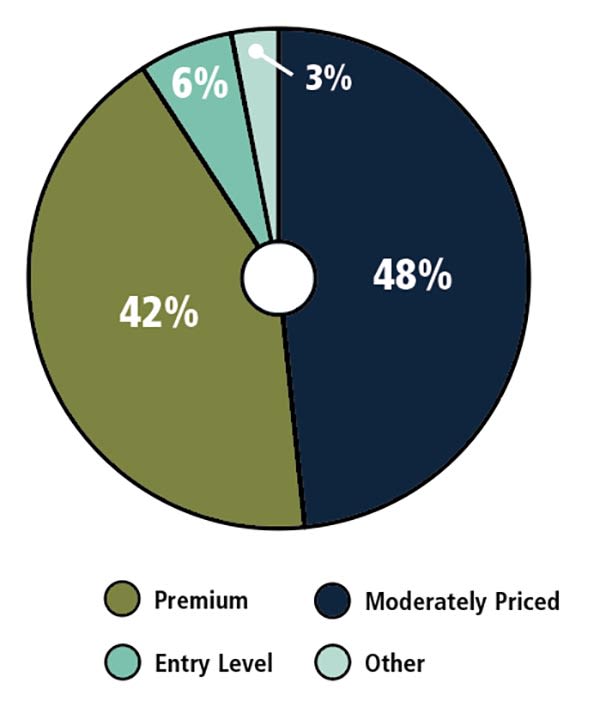
POTENTIAL
Q: In which pricing tier for all products do you see the most growth on the retail side of your business today?
STRESS LEVELS
ECPs in the Northeast report being the most stressed at 5.7 out of 10, after they were the most relaxed among any region in 2024.
OPPORTUNITY KNOCKS
Q: What’s the one great area of opportunity on the retail side of your business today?
- Frames
- Lenses/Premium Product
- Myopia Management
- Contact Lenses
- Moderately Priced Product/Lens Add-ons
In Practice
What are some of the practice trends to look for in the Northeast during the remainder of 2025 and beyond?
• Scheduling Frequency. The vast majority of ECPs in the Northeast (85%) book appointments in shorter-than-one-hour slots, while 6% set aside exactly one hour, and another 3% schedule them for longer than 60 minutes.
• Purchasing Patterns. While 55% of eyecare professionals nationwide plan no changes to their frame purchasing, 52% of Northeastern ECPs are maintaining the status quo. Of those who are changing their mix, the highest percentage (18%) plan to increase inventory by 10% to 20%. As for spectacle lenses, a higher percentage of Northeastern ECPs (54%) plan to change their purchasing pattern compared with their peers in other regions.
• Frame Materials. Plastic is the material of choice, accounting for 85% of frames sold in the Northeast compared with 76% nationwide. At 6% each for all-metal and metal-plastic combinations, ECPs here sell fewer frames in these materials than their peers in the other regions.
• Lens Materials. Eyecare practices in the Northeast sell a higher percentage of polycarbonate lenses (64% of total lenses sold) than any other region and more high-index product than anywhere but the South. On the other hand, ECPs here sell fewer Trivex lenses than their peers in other parts of the country.

ONLINE RETAIL
Q: What products do you sell online?
• Contact Lenses. Nearly half (45%) of ECPs surveyed in the Northeast plan to increase their contact lens inventory by 10% to 20% this year. That’s the biggest change, up or down, for contact lens product in any region.
• Web Sales. Three-quarters of ECPs here (76%) don’t sell anything online. That puts them in last place in the nation when it comes to internet sales, especially in the contact lenses and reader categories. Additionally, 71% report having no plans to sell online within the next two years.
• Social Media. Nearly half (48%) of ECPs in the Northeast prefer Facebook, while 36% say Instagram is best, and another 15% give LinkedIn the nod.
Westward Way
Measuring trends in the West, a land of economic extremes.

Every region should be fortunate enough to have a state like California. Why? Because the Golden State’s economy surpasses not just that of any other state but of entire countries as well. In fact, for the second consecutive year, the state retains its position as the fourth-largest economy in the world.
The West region takes up almost half the land in the country’s 48 contiguous states. With a population of 80 million (second only to the South), the 13 states that make up the West are divided into two geographic areas: the Mountain Division and the Pacific Division. From major mountain ranges to its coastal shoreline, and from the rainforests of the north to its arid plains in the south, the West contains more biomes than any other region in the U.S.
The Employment Picture
The unemployment rate for April 2025 was 4.8% in the West. That’s the same number as March, but 0.3% higher than April 2024.
| HIGHEST UNEMPLOYMENT | LOWEST UNEMPLOYMENT |
| Nevada 5.6% | Montana 2.7% |
| California 5.3% | Hawaii 2.9% |
| Colorado 4.8% | Utah 3.1% |
| Oregon 4.7% | Wyoming 3.3% |
| Alaska 4.7% | Idaho 3.7% |
*Source: U.S. Bureau of Labor Statistics, April 2025
In terms of population, the South has what’s called the greatest net migration in, while the West is experiencing the largest net migration out. Despite California’s extraordinary economy, it leads the nation in net migration out, meaning more people are leaving it than moving in. The door opens both ways, however, and according to Pew Research, California, as well as Texas in the South region, is experiencing the highest influx of immigrants in the nation.
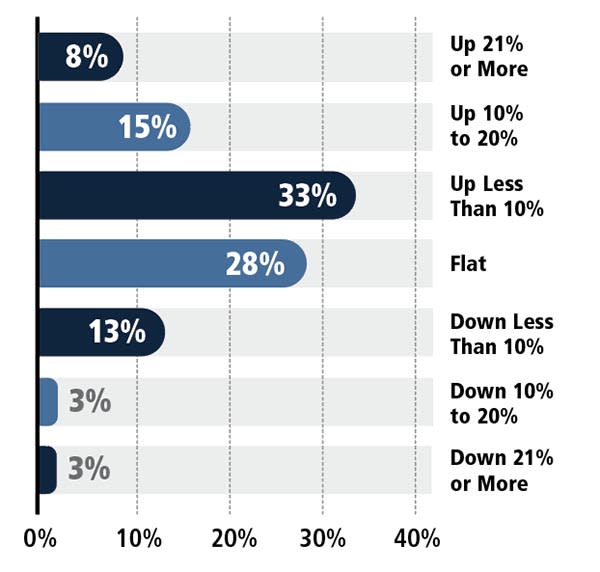
PROFIT PICTURE
Q: How is your bottom line trending in 2025 versus 2024?
56% of survey respondents in the West say their bottom line is trending up over 2024 levels, down from 75% last year.
How does all this affect the region’s economy? The cost of living here is second only to the Northeast. Its economic picture has been relatively consistent for several months. The region’s unemployment rate of 4.8% hasn’t changed since late last year, and its consumer price index showed a 2.1% increase for the 12 months ending in April. Though prices were up just 0.5% from March in the West, that’s the lowest year-over-year monthly increase so far in 2025. The 2.1% annual inflation rate matches the national average and it was the second lowest among the four Census Bureau regions in April after the South.
The West is also active in terms of integrating artificial intelligence into business and testing new real estate and business formats. One example? Mixed-use facilities. That means combining multiple entities—like commercial, retail, manufacturing, and sometimes even residential—into a single facility.
What about optical? With one-third of practices surveyed up less than 10% year over year, the West is pretty much on par with the bottom line of businesses in the other three regions. In terms of product, however, ECPs in the West are nearly twice as keen on myopia management products as their peers in other regions.

POTENTIAL
Q: In which pricing tier for all products do you see the most growth on the retail side of your business today?
STRESS LEVELS
The West’s average stress levels are 4.2 out of 10, coming in as the most relaxed region in the country despite the notable jump from 3.3 last year.
OPPORTUNITY KNOCKS
Q: What’s the one great area of opportunity on the retail side of your business today?
- Myopia Management
- Premium Product
- Frames
- Spectacle Lenses
- Contact Lenses
In Practice
Whether for right now or to help plan for next year, it’s important to take into account what your peers are doing. Here’s a look at a few key areas.
• Scheduling Frequency. On par with other regions, 84% of ECPs in the West book more than one appointment per hour.
• Purchasing Patterns. Although just over half (53%) of practices anticipate no changes, 35% (notably higher than any other region) expect to boost frame purchases by 10% to 20% this year. When it comes to spectacle lenses, 48% plan no changes, but 45% plan to increase purchasing by 10% to 20%—significantly surpassing the nationwide average of 31%. In the contact lens realm, half of those surveyed in the West have no plans to change their contact lens purchasing.
• Frame Materials. Three out of 4 frames sold here are plastic. Preferences closely parallel those of ECPs in the Midwest.
• Lens Materials. The majority of lenses sold here are polycarbonate (63%), although Trivex (20%) is sold more in the West than any other region.
• Contact Lenses. At 75% of sales in the category, single-vision daily disposables are hotter here than anywhere else. Nationwide, they account for only 58% of sales.

ONLINE RETAIL
Q: What products do you sell online?
• Web Sales. On par with national averages, 7 out of 10 practices in this region don’t sell online. That may change, however, as nearly a third (31%) report plans to start doing so within two years.
• Social Media. Fewer practices post on Facebook (35%) here than in other regions. An equal number (35%) use Instagram. That’s in contrast to the rest of the country, where only 28% of ECPs nationwide report they prefer Instagram over Facebook.

Success in the South
Fueled by explosive population growth and low inflation, the South is building economic momentum.
Almost 4 in 10 Americans (39%) call the Southern region home. Its 17 states combine to make it by far the most populous Census Bureau region in the U.S. To put that in perspective, the South has twice as many inhabitants as the Northeast and nearly twice as many as the Midwest.
To say it has experienced a population explosion is an understatement. Looking back to 2023, the South region accounted for a whopping 87% of the country’s rise in residents.
What do other key numbers indicate about the health of the region? Inflation here continues to be slightly lower than in other regions. In April, for example, in the South, inflation was 2%. In contrast, the overall U.S. inflation rate was 2.1%.
The Employment Picture
Here are the region’s highest and lowest state unemployment stats for April, averaging to 3.8% for the region.
| HIGHEST UNEMPLOYMENT | LOWEST UNEMPLOYMENT |
| District of Columbia 5.8% | Maryland 3.1% |
| Kentucky 5.2% | Oklahoma 3.2% |
| Louisiana 4.4% | Alabama 3.3% |
| South Carolina 4.2% | Virginia 3.3% |
| Texas 4.1% | Tennessee 3.5% |
*Source: U.S. Bureau of Labor Statistics, April 2025
One of the South’s major metropolitan areas, Houston, did, in fact, record the lowest inflation rate among major metropolitan areas in the U.S. at 1%. On the other end of the spectrum, the Miami, West Palm Beach, and Fort Lauderdale area of Florida experienced the highest inflation rates in the first quarter of 2025 at 2.2%.
Looking at the last couple of years, National Business Capital reports that while residents of the Southern states have seen comparatively mild price hikes, residents there have reported more difficulty meeting expenses and experienced greater rates of credit card delinquency than people in most other regions.

PROFIT PICTURE
Q: How is your bottom line trending in 2025 versus 2024?
Fortunately, however, increased wages continue to outpace the South’s low (compared with other regions) inflation rate. That will be critical moving ahead through the rest of 2025.
So, what’s the problem? There still aren’t enough workers to fill all the job openings in the region. That being said, the U.S. Bureau of Labor Statistics reports that the April jobless rate in the South Census Region stayed at 3.8% for the sixth straight month. That’s up from a rate of 3.5% one year earlier, a number that helped the South register the lowest jobless rate in the country last year. Considering it’s the most populated region, that is impressive.
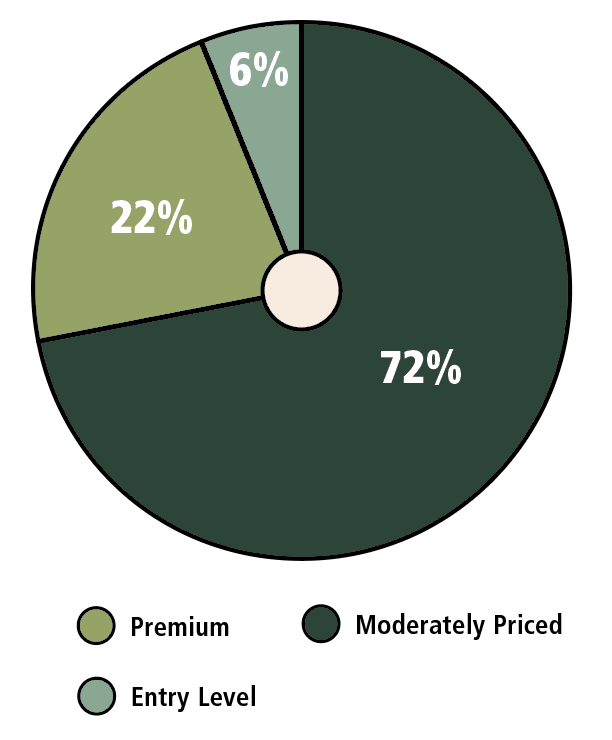
POTENTIAL
Q: In which pricing tier for all products do you see the most growth on the retail side of your business today?
When it comes to employment, one state definitely shines. At a 3.1%, Maryland has the lowest unemployment rate in the South region.
How does optical fit in with the overall economic and employment picture? When compared with other regions, the South stands out on both ends of the spectrum. Nearly 1 in 10 practices in the region (9%) has seen a huge leap of 21% or more in business so far this year—more than any other region. On the other hand, business is either flat or down for 32% of practices in the region.
STRESS LEVELS
The average stress level for ECPs in the South is 5.3 out of 10, a notable climb from 4.5 last year when they were the most stressed region in the country.
OPPORTUNITY KNOCKS
Q: What’s the one great area of opportunity on the retail side of your business today?
- Myopia Management/
Premium Product - Frames
- Contact Lenses/Moderately Priced Product
- Lenses
- Lens Add-ons
In Practice
In terms of eye care and eyewear, here’s an up-close look at some of the practice trends in the South that are playing out now and will most likely continue into at least early next year.
• Scheduling Frequency. The vast majority of respondents (85%) spend less than an hour with a patient. Unlike other regions, no ECPs surveyed here say they spend longer than an hour. As for walk-ins, 6% of practices accept them. That makes the South one of only two regions in which some survey participants indicate they accept walk-in business.
• Purchasing Patterns. More ECPs here than in any other region (63% versus 55% nationwide) don’t plan to alter their frame purchasing plans this year. Of those who do, the largest number (19%) report they are cutting back their inventory by 10% to 20%. When it comes to spectacle lenses, 59% of survey respondents in the South say they’re making no change to purchases. That’s right on par with the national average of 56%. As for contact lenses, although 44% of ECPs here aren’t changing their mix, another 34% say they’re increasing their contact lens purchases by between 10% and 20%.
• Frame Materials. ECPs here sell fewer plastic frames than their counterparts in other areas (63% versus 76% nationwide) but more than twice as many combination metal-plastic frames (28%) as the national average (12%). As for all-metal products, sales in the South are right on par with the national numbers (9%).
• Lens Materials. Just over half the prescriptions here (53%) are filled with polycarbonate lenses. Another favorite? High index. In fact, eyecare pros here sell more high-index lenses (16%) than any other region.
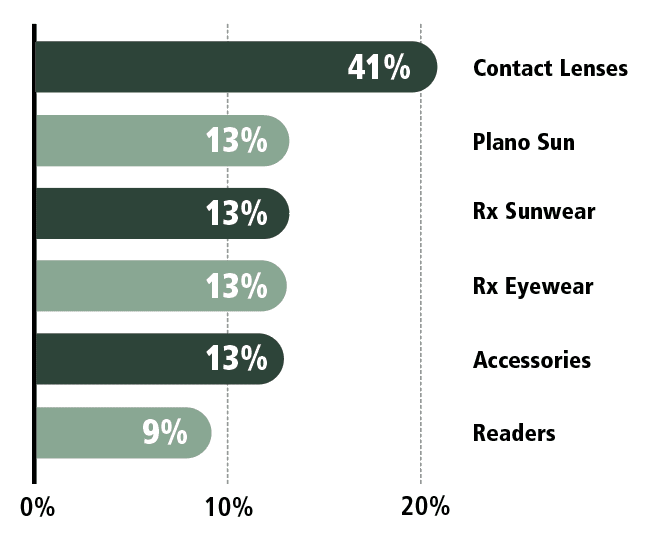
ONLINE RETAIL
Q: What products do you sell online?
• Contact Lenses. ECPs here prescribe fewer single-vision and multifocal daily disposables but a lot more single-vision extended wear lenses (34% versus 23% nationwide) than practitioners in other regions.
• Web Sales. More practices here sell product online (44%) than those elsewhere do, especially contact lenses. All told, more than 4 out of 10 (41%) of practices here sell contacts online. That’s a lot more than the 25% of their counterparts nationwide who do so.
• Social Media. On par with national numbers, exactly half (50%) of ECPs in the South prefer Facebook for business over other platforms, whereas 28% use Instagram the most.

Making it in the Midwest
Defined by steady resilience and tradition, growth in the Midwest is modest but reliable.
Manufacturing is more important to the Midwest’s GDP than it is to other regions’ economies. Despite a drop in production here—hence the name “the Rust Belt”—the Heartland’s economy will nonetheless show growth this year, though at a slightly slower pace than in 2024.
Some, however, see a strong need for greater investment in infrastructure throughout the region. In response to concerns over tariffs, companies here are already juggling and expanding their supply-side resources.
How are small businesses faring in the region? According to the U.S. Chamber of Commerce, they are less likely to be adding staff either this year or next than their peers in other parts of the country. And, although more than half of small businesses nationwide consider themselves to be in good health, only 22% of those in the Midwest are feeling that positive.
The Employment Picture
Two Midwestern states, South Dakota and North Dakota, have the lowest unemployment numbers in the nation. In contrast, however, Michigan is experiencing the third-highest jobless rate in the country. As calculated by the U.S. Bureau of Labor Statistics, here’s an up-close look at the region’s employment highs and lows for April 2025, averaging to 4.2% for the region.
| HIGHEST UNEMPLOYMENT | LOWEST UNEMPLOYMENT |
| Michigan 5.5% | South Dakota 1.8% |
| Ohio 4.9% | North Dakota 2.6% |
| Illinois 4.8% | Nebraska 3.0% |
| Indiana, Missouri 3.9% | Minnesota 3.2% |
| Kansas 3.8% | Wisconsin 3.3% |
*Source: U.S. Bureau of Labor Statistics, April 2025
As for inflation, the region’s consumer price index was 2.4% for the 12 months ending in April—a bit higher than the national rate of 2.3% for the same period.
Another measure? The Best States rankings by U.S. News & World Report draw on thousands of data points to measure how well states are performing for their citizens. This year’s rankings place two Midwestern states, Minnesota and Nebraska, among the top five in the country.

PROFIT PICTURE
Q. How is your bottom line trending in 2025 versus 2024?
As for personal income, according to the U.S. Bureau of Economic Analysis, some Midwest states, including Iowa and Indiana, have average hourly wages near or below the national median. On the opposite end of the spectrum, others, including Minnesota and Illinois, have higher household incomes than the national median.
The Midwest is also the most affordable region in terms of housing. That’s one reason it is experiencing at least modest population growth this year.
How is all this impacting and playing out in optical?
One out of 5 practices surveyed in the Midwest reports that their bottom line is down this year. That represents a bigger drop than ECPs in any other region have recorded so far in 2025. On the other hand, more than half (55%) report sales are up year over year.
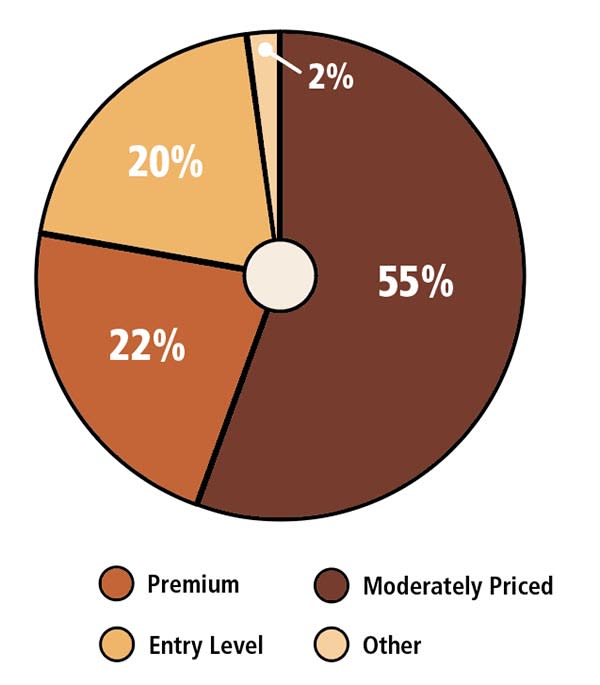
POTENTIAL
Q. In which pricing tier for all products do you see the most growth on the retail side of your business today?
STRESS LEVELS
Second to only the Northeast in terms of stress, the average stress level of ECPs in the Midwest is 5.4 out of 10, up from 4.1 last year.
OPPORTUNITY KNOCKS
Q. What’s the one great area of opportunity on the retail side of your business today?
- Lenses/Moderately Priced Product
- Contact Lenses/Lens Add-Ons
- Frames/Premium Product
- Myopia Management
- Entry-Level Products/Medical Services
In Practice
What about optical-specific trends and stats? Here are several key ones as of late April. Most are expected not to change much, at least through early next year.
• Scheduling Frequency. On par with national numbers, 84% of ECPs here say they schedule appointments for less than an hour. It’s also one of only two regions where respondents indicate they accept walk-ins.
• Purchasing Patterns. Similar to the West, approximately half of the ECPs in the Midwest (55%) aren’t changing their contact lens buying plans this year. More than any other region, however, almost one-quarter (24%) of practices here will be cutting back frame purchases by 10% to 20%. Similarly, a whopping 67% of Midwestern respondents (compared with 56% nationally) aren’t altering their spectacle lens buying for the rest of this year.
• Frame Materials. With 8 out of 10 prescriptions filled with plastic frames in the Midwest, only the Northeast sells a higher percentage of all-plastic product.
• Lens Materials. Just over half of practices (51%) currently carry polycarbonate lenses in the Midwest, a bit lower than the national average of 56%.
• Contact Lenses. At 49% of contacts sold, single-vision daily disposables are the most popular contact lens modality in the Midwest. On the other hand, only 2% of contacts sold here are multifocal extended-wear lenses.
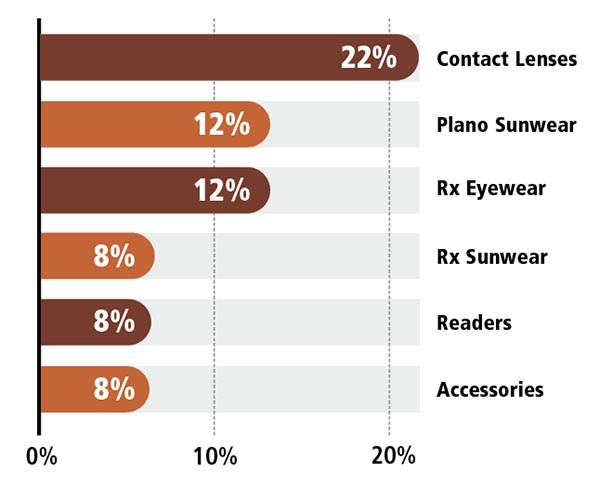
ONLINE RETAIL
Q. What products do you sell online?
• Web Sales. With 73% of Midwestern ECPs not selling on the internet at all, only the Northeast registers fewer online sales than ECPs here. Looking ahead, only 17% of those practitioners in the Midwest say they plan to start selling online within the next two years.
• Social Media. Midwestern ECPs are definitely Facebook fans, with 73% of them calling it their preferred platform for business. That’s a lot more than the 53% of practitioners nationwide who prefer Facebook more than any other social media platform.



